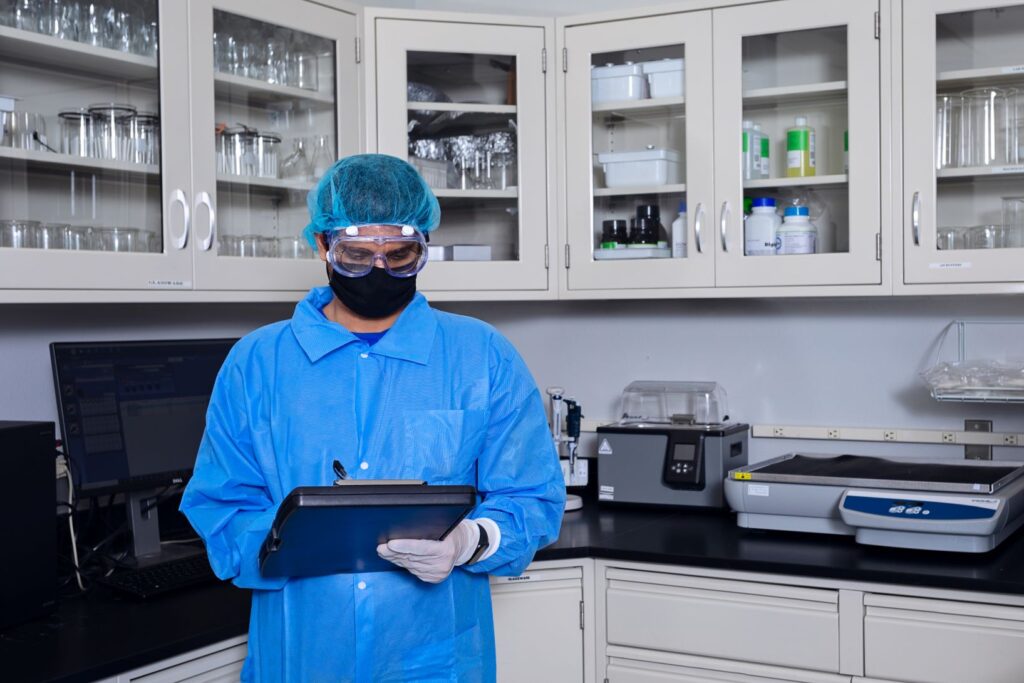According to the International Irradiation Association, over 40% of all single-use medical devices produced globally are sterilized using gamma radiation. This sterilization method ensures the highest standards of patient safety and the optimal functionality of medical devices.
In this article, we will explore what gamma sterilization is, why it is important to medical devices, and how it contributes to the safety and efficacy of medical device packaging. We will also explore its advantages, walk through the step-by-step process, and ponder its promising future potential.
What is Gamma Sterilization?
Gamma sterilization is a highly effective method used in healthcare to eliminate harmful microorganisms from various materials, including medical devices, pharmaceuticals, and tissue grafts.
Utilizing the high-energy gamma rays emitted from cobalt-60, this method is adept at penetrating deeply into materials to disrupt the DNA of microbes, preventing infection and proliferation. While cesium-137 may serve as an alternative, its lower energy output restricts its use, making cobalt-60 the preferred choice due to its effectiveness and efficiency.
Significance in Healthcare
The reason why gamma sterilization is crucial in healthcare lies in its ability to ensure patient safety. The Centers for Disease Control and Prevention (CDC) reports that on any given day, about 1 in 31 hospital patients has at least one Healthcare Associated Infection (HAI).
By eradicating pathogens from medical devices and supplies, it helps prevent infections, safeguard patient health, and maintain the integrity of medical equipment, making it an indispensable tool in modern healthcare.

Ensuring the Safety of Medical Device Packaging
Gamma sterilization plays a pivotal role in the world of medical device packaging. It is instrumental in ensuring that a vast array of medical devices remains free from harmful microorganisms before reaching patients. That’s why devices that come into direct contact with patients, such as surgical instruments and implants, must undergo gamma sterilization to meet stringent safety standards.
Specifically, the International Organization for Standardization (ISO) has established ISO 11137 for the sterilization of healthcare products. This standard provides guidelines and requirements for the validation and routine control of gamma sterilization processes, ensuring that the sterilization of medical device packaging meets the highest industry standards.
Infection Control and Quality Assurance
As infection control is a cornerstone of healthcare, gamma sterilization is one of the essential tools to achieve this objective. By eliminating pathogens residing on medical devices and supplies, it helps healthcare providers maintain a safe and sterile environment within healthcare facilities. This, in turn, significantly reduces the risk of healthcare-associated infections, safeguarding patient well-being.
Moreover, gamma sterilization is a guardian of the safety and efficacy of healthcare products in general. It ensures that these products are not only safe for patients but also effective in their intended purpose. By eradicating microorganisms from medical devices often implanted inside the patient’s body, gamma sterilization is a key tool to protect patient health.
Advantages of using Gamma Sterilization
With approximately 40 billion medical devices sterilized annually in the U.S., gamma sterilization is one of several alternatives and the choice is mainly determined by the type of device and packaging being used. Other sterilization methods for medical devices include Ethylene Oxide, e-Beam, and Steam.
However, the methodology of gamma sterilization stands out in the medical field not only for its effectiveness but also for the array of benefits it brings to the table. These advantages are particularly significant given the nature of medical device sterilization, where the margin for error is virtually nonexistent.
- Consistency and Reliability: Gamma sterilization is known for its consistency and reliability. It delivers a predictable and uniform level of sterilization, ensuring that every treated item meets the same stringent safety standards.
- Compatibility with Diverse Materials: Unlike some other sterilization methods, gamma sterilization is highly compatible with a wide range of materials commonly used in healthcare, such as plastics, rubber, metals, and even sensitive electronic components. This versatility is important so that a broad spectrum of medical devices and products can undergo sterilization without compromising their integrity.
- Deep Penetration: Gamma radiation possesses the unique ability to penetrate deeply into materials, reaching even complex and hard-to-access areas of medical devices and packaging. Thanks to this ability, no corner remains untouched by the sterilizing effect, and microorganisms are not able to survive, enhancing patient safety.
- No Residue: After gamma sterilization, there is no residual chemical or byproduct left behind on the treated devices, which eliminates the need for additional rinsing or cleaning steps, simplifying the sterilization process and reducing the risk of potential contaminants.
- Non-Destructive: The process is non-destructive to materials, meaning that it does not compromise the structural integrity or functionality of medical devices or packaging. This also ensures that the sterilized products retain their intended design and performance characteristics.
- Regulatory Compliance: Gamma sterilization facilities adhere to strict regulatory standards and guidelines,. Detailed records are maintained throughout the sterilization process, offering a transparent and auditable history of sterilization for regulatory purposes.
The step-by-step process of Gamma Sterilization
Going from the theoretical virtues to the practical application, we’ll now walk through the meticulous step-by-step process that provides medical devices sterility and safety through gamma sterilization. It’s important to note that every stage of this process is designed to uphold the highest standards of sterility while simultaneously preserving the functionality and longevity of medical products.
- Preparation of Items: Before sterilization itself, all items to be treated undergo thorough cleaning and packaging in specially designed containers or pouches. Packaging is crucial at this point as it not only protects the items but also allows gamma radiation to penetrate effectively.
- Loading: Prepared items are loaded into racks or trays, which are then placed within the sterilization chamber. The arrangement of items within the chamber is carefully planned to ensure even exposure to gamma radiation.
- Irradiation: The loaded sterilization chamber is positioned within the irradiation facility, where it is exposed to high-energy gamma rays. These gamma rays are emitted from a radioactive source, typically cobalt-60 or cesium-137, as we mentioned earlier. The radioactive source is securely shielded to prevent radiation leakage and protect the environment.
- Dosimetry: Dosimeters, which are specialized devices designed to measure the absorbed dose of radiation, are strategically placed within the sterilization chamber. They help monitor and verify that the items receive the intended radiation dose, securing consistent and effective sterilization.
- Radiation Exposure: The items are, then, exposed to gamma radiation for a predetermined period, which is carefully calculated based on the required sterilization dose. This dose is measured in grays (Gy), and the exposure time is precisely calibrated to achieve the desired level of sterility.
- Quality Control and Monitoring: Throughout the irradiation process, the facility maintains strict quality control measures. Technicians continually monitor and record key parameters, including radiation levels, exposure time, and temperature.
- Dose Verification: After irradiation, samples of the treated items are collected and analyzed to verify that they have received the correct radiation dose and have achieved the required level of sterility. This step is crucial for quality assurance and regulatory compliance.
- Documentation: The entire sterilization process, including the dosimetry data, exposure parameters, and quality control measures, is meticulously documented and archived. Later on, these records serve as essential documentation for regulatory authorities, quality audits, and product traceability.
- Release of Sterilized Items: Once the sterilization process is completed and validated, the treated items are released for use in healthcare settings. They are considered safe, free from harmful microorganisms, and ready for deployment in patient care.
The thorough process of gamma sterilization aims for a standard Sterility Assurance Level (SAL) of 10^-6, reflecting the high level of sterility required for medical devices. To clarify, the Sterility Assurance Level (SAL) of 10^-6 means that there is less than or equal to one chance in a million that a sterilized item is non-sterile after the process. This industry benchmark ensures that products are sterilized to a level where the probability of a viable microorganism is extremely low, securing the method’s effectiveness.
Other Things to Consider
Besides the core process of gamma sterilization, several other crucial aspects merit consideration to ensure its effectiveness and safety:
Time and Intensity Considerations in Gamma Sterilization
In the process of gamma sterilization, the duration of exposure and the intensity of radiation are calculated to meet the stringent requirements set by healthcare regulations and industry standards. These considerations are essential to achieve effective levels of sterility while safeguarding the integrity and functionality of medical products.
Several key factors influence the time and intensity considerations in gamma sterilization, with adherence to standards such as ANSI/AAMI/ISO 11137 ensuring precision and effectiveness:
- Required Sterility Level: The level of sterility required for the items, as determined by healthcare regulations and industry standards, influences the duration and intensity of radiation exposure.
- Item Composition: The composition and complexity of the items to be sterilized significantly influence the required radiation dose. Certain materials may demand longer exposure times to ensure complete sterilization.
- Radiation Dosimetry: Dosimeters, strategically placed within the irradiation chamber, monitor the absorbed radiation dose. This data is analyzed to calculate the precise exposure time needed to achieve the desired level of sterilization, in accordance with ANSI/AAMI/ISO 11137 and other relevant standards.
- Quality Control Samples: Samples of the treated items are regularly tested to confirm that they have received the correct radiation dose. This ensures that the items have achieved the required level of sterility.
- Regulatory Compliance: Gamma sterilization facilities must adhere to regulatory guidelines regarding radiation exposure limits, ensuring that the sterilization process complies with safety standards.
Future of Gamma Sterilization
While we contemplate the future of sterilization in healthcare, it’s evident that gamma sterilization will continue to play a pivotal role in ensuring the safety and efficacy of medical products. However, we should also acknowledge ongoing research and innovations in alternative sterilization methods that may reshape the landscape of healthcare sterilization.
As we already mentioned, there are approximately 40 billion medical devices being sterilized annually in the U.S. And, with rapid advancements in medical technologies as well as demands for sterility, it’s become obvious the future of sterilization encompasses not only the evolution of gamma sterilization but also the exploration of alternative approaches. The U.S. Food and Drug Administration (FDA) and other regulatory bodies have been actively encouraging the development and adoption of new sterilization methods that are less reliant on traditional agents like ethylene oxide. Methods such as X-ray and electron beam (e-beam) sterilization are also gaining prominence.
In this evolving landscape, packaging itself will undergo transformative changes. It remains a critical component in the safeguarding of medical products, serving as the last line of defense before reaching patients. Innovations in packaging materials and design will not only enhance compatibility with traditional sterilization methods like gamma radiation but also accommodate other sterilization technologies like X-ray and e-beam.
With its numerous advantages, such as consistency, compatibility with diverse materials, deep penetration, and regulatory compliance, gamma sterilization still stands out as a reliable and efficient method for achieving high levels of sterility. Its non-destructive nature and the absence of residue further emphasize its suitability for a wide range of medical devices and products. The synergy between it and emerging alternatives is poised to define the future of sterilization in healthcare.

Summary
- Gamma sterilization is crucial for medical devices, with over 40% of global single-use medical devices sterilized using gamma radiation.
- It ensures patient safety by eliminating harmful microorganisms, preventing infections, and maintaining medical equipment integrity.
- Gamma sterilization is pivotal in medical device packaging, meeting stringent safety standards outlined by the International Organization for Standardization (ISO).
- The process involves thorough preparation, irradiation, dosimetry, quality control, and documentation.
- Advantages include consistency, material compatibility, deep penetration, no residue, and regulatory compliance.
- Time and intensity considerations are crucial in gamma sterilization, tailored to achieve the required sterility level for specific items.
- Ongoing research into alternative sterilization methods like X-ray and e-beam sterilization is gaining prominence, offering unique advantages such as reduced chemical usage.
- Innovations in packaging materials and design are anticipated to accommodate both traditional and emerging sterilization technologies in the future.

